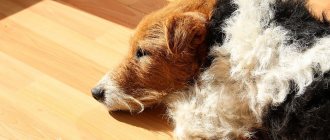The Fox Terrier breed is a hunting dog breed. They were bred specifically to hunt certain animals, which is why they have a unique character and habits.
It is better to get them for hunting, but if you like the dog so much that you want to have such a friend at home, you need to be prepared for training and long walks, during which the pet must realize its hunting instincts.
Breed characteristics
| Short description | |
| Origin: | England |
| Conditions of detention: | In an apartment, in a house |
| Purpose: | Companion dog, hunting dog |
| Color: | Tricolor (black and tan spots on a white background) |
| Wool length: | Short coat for smooth coats and medium wiry coat for wire coats |
| Adult dog size: | Height at withers – 35-40 cm, weight – up to 8 kg |
| Average life expectancy: | 12-15 years |
| Walk: | Daily long |
| Physical activity needs: | Average physical activity needs (walking 1 to 3 hours per day) |
| Fédération Cynologique Internationale (FIC) classification: | Group No. 3 terriers, section No. 1 large and medium terriers |
| Puppy price: | From 10,000 rubles - purebred pet-class puppies, from 20,000 rubles - show-class puppies, the price for babies from titled champion parents can reach 50 - 60 thousand rubles |
Protective and guard qualities
The pet’s jealous attitude towards strangers, distrust of the appearance of “new people”, and the desire to protect its pack from invasion allow the fox terrier to act as an excellent and impeccable guard. Its modest size does not mean at all that the dog is not strong and brave enough to provide adequate protection to the owner and his family.
A fox terrier dog can raise the alarm if third parties attempt to break into the house. The dog's zeal and persistence will frighten any intruder. The Fox Terrier is an excellent guard dog. Fearlessness and intelligence help the dog to be a family guard. But these qualities need to be developed in the dog if you want the fox terrier to be a guard.
History of the origin of the species
Fox Terriers began to be bred in England for a specific purpose - to hunt foxes in holes. Hence the name of the breed - “ fox ” translated from English as “ fox ”, “ terra ” - earth in Latin.
Written references to the ancestors of the Foxes date back to the 11th century. The first famous lover of the breed to engage in its targeted selection was Count Montey. He paid special attention primarily to the working qualities of dogs, and not to their exterior. After some time, breeders began to care about the appearance of the fox terrier. In order to get it in its modern version, the ancestors of Foxes crossed with bull terriers, hounds, spaniels, dachshunds and beagles. The main task was to preserve the authenticity of the breed and improve its merits.
Fox terriers gained popularity at the end of the 18th century. It was at this time that fox hunting became extremely widespread throughout Great Britain and became a national sport. Foxes became an integral part of this entertainment; they helped hunters by driving foxes out of their holes.
At this time, breeders turned to questions of dog color . A desire began for the predominance of white in the coloring of dogs in order to make pets as different as possible from bright foxes jumping out of holes, and to reduce the chance of accidentally shooting a fox terrier instead of prey. All large individuals were also rejected, since their wide chest prevented them from crawling into the narrow passages of the burrows.
In the 19th century, the breed was finally formed in its modern form.
These dogs were presented at the exhibition for the first time in 1859. The first monobreed show, with almost 200 participants, took place already in 1886.
At the same time, Fox Terriers began to be divided into two separate breeds - smooth-haired and wire-haired, but the breed standard was still the same. Moreover, until the 20th century, the main population consisted of smooth-haired individuals, but today lovers of the breed increasingly prefer wire-haired dogs.
At the end of the 19th century, representatives of the breed began to be actively exported outside of England throughout Europe and to Russia.
Although the first fox terrier came to the territory of our country much earlier. The puppy was brought to St. Petersburg in the 60s of the 19th century as a gift to Prince Golitsyn . He is considered the first Russian Fox fan in Russia.
A little history of the breed
Initially, fox terriers specialized in catching rodents and burrowing animals. The first mention of them dates back to 55 BC. Already in the 14th century, the British began to involve four-legged animals in burrow hunting.
According to historical information, the first hunting trips took place with smooth-haired animals, which were introduced during the crossing of the Old English Black and Tan Terrier with the Greyhind, Bull Terrier and Beagle.
You can see photos of fox terriers at any dog club or online. Wirehairs appeared around the end of the 19th century.
Distinctive features
The FCI makes a clear distinction between smooth and wire fox terriers. However, the difference in the breed standard is essentially only in the description of the dogs' coat.
Thus, in wire-haired dogs, the most rigid, wiry-like coat is welcomed . The hair is dense, medium length. Slightly longer on the back and legs than on the whole body. A kind of beard is formed on the muzzle, which gives the muzzle an unusual expression and rectangular shape.
Wire Fox Terrier
Read the detailed article: “Wire Fox Terrier - friendliness, enthusiasm and fearlessness in one dog.”
Smooth-haired cats have dense, short fur. The same throughout the body, only a little shorter on the muzzle and paws.
Smooth Fox Terrier
Otherwise the breed standard is similar:
- The body is strong and muscular, tends to square proportions (the length of the body is equal to its height);
- The body is narrow, seems light and taut like a spring;
- The head is flat, tapering towards the nose; the transition from the top of the head to the nose is almost invisible;
- Cheekbones are narrow;
- bite ;
- The jaws are strong with a full set of teeth;
- The eyes are round and dark;
- The ears are small, triangle-shaped; stand upright, but the tips are slightly lowered forward;
- The chest is narrow;
- The stomach is tucked;
- The legs are straight and strong with pronounced muscles;
- color - red and black spots on a white background; less common is two-color (according to the standard it is also acceptable, but not so loved by breeders) - white with red or brown spots;
- The tail is set as high as possible and looks upward; most often stopped; has rare strength (it can be used to pull and lift the dog if necessary). The Fox Terrier does not wag its tail like other breeds. He makes short movements, as if he is shaking.
The weight of dogs ranges from 6 to 8 kg , females weigh slightly less. The height of the dog at the withers is from 35 to 40 cm.
Fox Terrier Appearance
Fox Terrier puppy
Moderation in everything is the main principle that guided breeding specialists when shaping the appearance of the modern fox terrier. Bony but not coarse, stocky but not squat, these agile, robust creatures are a true example of stateliness and hunting elegance. With a relatively small height (up to 39 cm), Foxes, however, do not give the impression of decorative sofa pets. Moreover, just the look of the dog already indicates that this is a strong personality, to whose heart and mind you will need a special key, and, perhaps, a whole set of different-sized master keys.
Head
The upper part of the Fox Terrier's skull is flat, the length of the head and muzzle is approximately the same. The stop is very small, smoothed type.
Jaws
Fox Terriers have very strong jaws with a full, scissor bite.
Nose
The lobe is black in color and medium in size.
Eyes
The Fox Terrier's eyes are small, round, without noticeable bulge. The iris is painted in a dark shade.
Ears
All Fox Terriers have small, triangular-shaped ears, the tips of which droop down toward the cheekbones.
Neck
The Fox Terrier's neck is dry, but with fairly developed muscles, gradually thickening towards the body.
Muzzle of a Smooth Fox Terrier
Muzzle of a Wire Fox Terrier
Frame
Fox Terrier from behind
The dog's back and lower back are short, level and muscular. The chest is deep, with convex false ribs.
Legs
The front legs are straight, with long shoulders and elbows pointing back. Hind legs with massive, elongated hips and steep metatarsals. Fox Terrier paws are compact, round in shape with elastic pads.
Tail
The dog's tail is traditionally docked at 1/3. The exception is European countries where this procedure is prohibited by law. The docked tail of a Fox Terrier should be carried strictly vertically, without falling to the side or curling.
Wool
Wire Fox Terriers boast a lush “coat” of coarse, wiry hair, 2 to 4 cm long. The smooth-haired variety has a shorter and thicker coat, and the hairs lie tightly to the body.
Color
The classic color type of fox terriers is white with black, black or tan markings throughout the body.
Wire Fox Terrier at a dog show
Disqualifying features
- Blue, coffee and red markings on the coat. Presence of brindles.
- Downy wool.
- Depigmented or spotted nose.
- Ears erect or drooping, like a hound's.
- Overshot or undershot.
Photo of an adult dog
Smooth Fox Terrier
Wire Fox Terrier
Health
If you are purchasing a Smooth Fox Terrier puppy, find a reputable breeder who can provide a pedigree for both parents. Inquire about the physical health of your ancestors over several generations.
Thus, there is a greater chance of having a healthy and smart pet. Undoubtedly, the price of a puppy with a good pedigree will be significantly higher than the price of a pet with a lesser known pedigree.
The risk of pathologies will decrease if the parents of the Smooth Fox Terrier puppy are older than two years.
Photos of puppies
Features of character and behavior
Each breed of dog has its own characteristics of behavior and character. The Fox Terrier is no exception; its temperament has both pros and cons.
Advantages
- The Fox Terrier is incredibly energetic. It is suitable for active people who love walks in the fresh air and active recreation.
- Fox will easily endure any trip accompanied by his owner. For families with children, this breed is a godsend. The dog will happily frolic with children of any age, and will also patiently tolerate and support the pranks of the youngest family members.
- The Fox Terrier is friendly, playful, hardy and easy-going. He is ready to tirelessly be the center of attention of the whole family around the clock.
- These dogs are quite good-natured towards strangers. But at the first sign of aggression, the pet will rush to defend itself or its owner.
Flaws
This breed is not suitable for homebodies or workaholics; in the absence of the owner, the pet will develop blues, and over time, signs of disobedience.
This is a dog that needs to be given quite a lot of time and attention.
It is possible to keep a Fox Terrier in the same territory with another dog, despite the jealousy inherent in the breed. But if there are cats, parrots and rodents in the house, buying such a dog is definitely not the best idea. The rest of the pets will be in constant danger of becoming prey, because Foxes have a very well developed natural hunting instinct.
This breed has a loud character and the pet often barks for various reasons. When kept in an apartment, this can lead to conflicts with neighbors.
Pros and cons of fox terriers
For those who are still thinking about whether it is worth getting a restless hunter, we present in the form of a table the positive and negative aspects of these dogs:
| Pros of the breed | Cons of the breed |
| Cheerful disposition | Hypermobility |
| Suitable for keeping in a city apartment | Needs long walks |
| Excellent hunting skills | Doesn't get along well with other pets |
| Unpretentiousness in care and nutrition | Constant loud barking |
| Devotion | The owner must be able to prove his dominance |
| High intellectual abilities | Stubbornness |
Everyone decides for themselves which breed to choose, but the characteristics of the dogs must be taken into account.
Care and maintenance
Fox Terriers are not large in size or shed heavily, which is why they feel great both in a house with adjacent territory and in a small city apartment.
Basic dog care will not take much time:
- Trimming nails as needed;
- Examination and rubbing of eyes;
- Timely cleaning of ears and teeth.
Nutrition
Nutrition is an important aspect of caring for these dogs . Overeating is dangerous for them. Therefore, you need to calculate portions not only based on the size of the pet, but also on its activity level.
You can feed your Fox Terrier both dry food and natural food. In any case, veterinarians never tire of repeating that a dog’s diet should be balanced. That is, if it is a dry mixture, you need to choose a holistic, super-premium or premium class. Before purchasing, it is better to read reviews and study the composition of the food, and also check with a consultant in the store whether this option is suitable for the breed.
When choosing natural food, your pet needs to create a high-quality, complete diet. Feeding table scraps to your dog is strictly prohibited!
Recommended products for Fox:
- Raw (frozen or scalded with boiling water) or lightly cooked lean meat;
- Boiled offal (liver, heart);
- Sea fish with bones removed;
- Cottage cheese, kefir;
- Vegetables;
- Cereals (buckwheat, rice, oatmeal);
- Fruits other than citrus fruits;
- A little greenery.
It is strictly forbidden to feed your pets fried, flour, sweet, smoked, peppered and fatty foods.
When buying a small puppy, the emphasis in the diet is on fermented milk products and cereals . A two-month-old puppy is fed 6 times a day at regular intervals. Then gradually reduce the number of servings from 6 to 2 per day, and also reduce the amount of fermented milk products, replacing them with meat. Adult Foxes from the age of one are fed twice a day .
As activity decreases, the portion size should also be reduced to avoid excess weight gain.
We recommend that you read a detailed article on the topic: “How and what to feed a dog: types and characteristics of nutrition.”
Health
Fox Terriers are real long-livers . With proper care, they live more than 15 years. However, for such a result it is necessary to know the diseases to which the breed is predisposed, to be able to prevent them or to notice and treat them in time.
Vaccinations
Proper and timely vaccination is also the key to your pet’s health.
- For the first vaccination at 6-8 weeks, you need to treat the animal with all parasites (external and internal) in advance - 10-14 days before going to the doctor. At your appointment, your veterinarian will explain what medications are on the market and how they differ.
- Most often they recommend Biovac, Kanigen, Nobivak or Eurikan. The cost of the vaccine will depend on the chosen medicine (from 200 to 2,000 rubles).
- At 12 weeks a booster vaccination is required.
- Then the vaccine is given 6-7 months after the change of baby teeth to molars.
- At 12 months, another vaccination is given - against diseases (distemper, enteritis, parainfluenza and others) and against rabies.
Sometimes veterinarians advise vaccinating your pet against rabies at an earlier age. Only the owner decides whether to do this or not. After each vaccination, the dog will feel a little stressed and will be more lethargic than usual for a day or two.
Also, for 10-14 days, you should not give her heavy physical activity or take her out into large crowds of people or animals.
Important article on the topic: “Everything you need to know about dog vaccinations.”
Diseases
Fox Terriers have good genetics, but there are several diseases that this breed is prone to:
- Dysplasia and other joint problems. This manifests itself mainly in adulthood and is a consequence of too much activity of the pet.
- Eye diseases (cataracts, melanoma, glaucoma). These are manifestations of heredity in most cases. In this case, there are no preventive measures other than close observation and examinations by a doctor.
- Diabetes, obesity, gastrointestinal dysfunction. These problems are associated with poor nutrition. With a nutritious diet, owners will be able to avoid them.
Walk
Fox Terriers need long daily walks. Moreover, these should not be easy walks in the park, but an active pastime. Running, games, agility - all this is welcome.
Foxes are very playful, so a ball, frisbee or a simple stick will be great entertainment for them . It is also recommended to socialize them from a young age and take them out to playgrounds with other dogs. In puppyhood, fox terriers will easily get used to communicating with their own kind and will play with them with pleasure.
Residents of houses with adjacent territories are highly discouraged from simply letting their dogs out into the yard. They love to dig holes. The appearance of the lawn and any flower bed will be ruined if you leave your pet alone without supervision.
Grooming
There is no pronounced seasonal shedding in Foxes due to the lack of undercoat.
- However, smooth fox terriers require much less grooming - a simple brushing with a soft-bristled brush once a week is sufficient.
- Wire-haired dogs require a more careful approach - they need to be brushed with a stiff comb at least 2 times a week to avoid matting.
- Pets need to be trimmed several times a year to remove dead hair. If this is not done, various dermatological problems may appear.
Decorative haircuts are highly not recommended either for show dogs or for pets for the hobby. Any haircut can ruin not only the authentic appearance, but also the quality of the coat.
Bathing with shampoos should also be reduced to a minimum.
Characteristic diseases
Smooth Fox Terriers are generally a hardy breed, with no significant health problems. Some signs of disease do not appear until the animal reaches full maturity. But it is important to know what diseases representatives of this breed suffer from most often.
Signs of many diseases do not appear until the animal reaches full maturity.
The list of major diseases is as follows:
- With a predominance of color in white dogs, deafness is common. If such a problem is discovered, keeping and training a deaf dog will require a lot of attention, patience and time. To make life easier, there are many aids, vibrating collars, and other gadgets on the market.
- Older individuals are often predisposed to cataracts. Clouding of the lens of the eye causes vision difficulties, causing discomfort to the dog. Sometimes you have to seek the help of specialists to remove cataracts surgically. After the operation, vision is restored.
- A common disease among small breed dogs is hip deformity. It can be confused with hip dysplasia. The disease can be cured surgically, but the prognosis is good even after restorative therapy.
- Hip dysplasia is an inherited condition. In this case, the femur does not fit tightly to the hip joint. Dogs experience pain and lameness on one or both hind legs. But you may not notice any signs of discomfort in your pet due to hip dysplasia. As your dog ages, arthritis may develop due to the disease. Veterinary care includes supplements and medications to help relieve arthritis pain, and in some cases surgery is indicated. It is better not to breed dogs with hip dysplasia to prevent the disease from being inherited.
Mating
To successfully breed a pet, you need to follow some rules:
- The age for breeding a fox terrier is no earlier than 18 months ;
- Females can be mated no more than once a year , so she will have time to restore her body;
- After reaching the age of seven, breeding dogs is strictly prohibited.
For assistance in the correct selection of a pair and the mating process, it is recommended to contact the nursery where the dog was purchased. Professional breeders will give valuable advice and warnings to the Fox Terrier owner, and will also help in finding a match for the dog.
Before mating, it is advisable for the couple to take a good walk together to allow the dogs to get used to each other and it is advisable not to feed both of them the day before.
It is better to conduct acquaintance in advance on neutral territory. The mating itself is done only on the male's territory . It is better to obtain more detailed information on mating, pregnancy and childbirth from experienced breeders who have been dealing with the breed for a long time.
Read a detailed article on the topic: “Everything you need to know about breeding dogs: appropriate age, what to do if it doesn’t work out, rules and advice from breeders.”
Diseases and life expectancy
In general, the Fox Terrier is a healthy breed, without a large number of genetic pathologies. The lifespan of small hunters is on average 12-15 years, but some individuals live longer.
The dog is protected against parvovirus enteritis, hepatitis, leptospirosis and plague by vaccinations. Typically the vaccination schedule looks like this:
- 44-47 days – first vaccination;
- three weeks later - revaccination;
- after changing teeth - the third vaccination.
Then the vaccination is repeated once a year, after preliminary deworming.
There are not many congenital diseases, but they still exist:
- cataract;
- epilepsy;
- diabetes;
- dermatological problems;
- deafness;
- distichiasis;
- myasthenia gravis;
- joint pathologies;
- respiratory diseases;
- impaired blood supply to the head of the tibia (Legg-Calvé-Perthes syndrome).
These diseases cannot be avoided if the puppy is predisposed to them from birth. Therefore, it is very important to take a responsible approach to the process of choosing a pet.
Key points in training
Training fox terriers is generally easy. These dogs are smart and quickly understand what their owner wants from them.
However, there are several points that can overshadow the classes:
- Foxes are easily distracted. This means that the owner will have to put in quite a lot of effort to keep the dog's attention and concentrate on learning the commands. Professional trainers advise building lessons in the form of a game and bringing along as many treats as possible to keep the dog motivated throughout the training. It is better to start training individually; after a basic study of the basic commands, you can move on to group classes with other dogs.
- Fox Terriers often display dominance . Even a novice dog breeder can handle raising this breed, but to do this he will have to show a sufficient amount of patience, firmness and rigor. All actions must be consistent, and the owner must be a firm leader and not allow the dog to take over the situation.
- Zero tolerance for violence . Physical punishment of these dogs is highly discouraged. Not only can a fox terrier snap at its owner even when pain appears, but obedience in this situation will not be obtained from it. The dog will lose trust in its owner and harbor a grudge.
Read about how to properly train a dog in the article: “Training a puppy: effective methods from dog handlers, learning commands at home.”
If the owner is not sure that he can independently cope with the character of the Fox, it is better to conduct classes under the supervision of an instructor who will give instructions and advice on how best to structure the training and how to behave with the dog.
Attitude towards children
Fox Terriers get along well with children. We can give the highest rating - 5 out of 5. Children are very mobile and active, so neither the dog nor them together will be bored. If the dog is raised in its own home with a yard, active games will become a favorite pastime for the puppy and children.
Bringing toys and running after objects thrown to the dog are Foxes’ favorite pastimes. With proper training, the Fox Terrier can be an excellent dog for a family with children and an active lifestyle. A Fox Terrier and children can become best friends. Loyalty and devotion to pack members play a major role in the behavior of the fox terrier.
How to choose a puppy
Choosing a puppy is a very responsible matter.
Buying a baby fox terrier from an advert is highly not recommended. It is better to contact a nursery that specializes in this breed. There are quite a lot of Fox breeders both in the capital and in the regions, so the search will not take much time.
When choosing a baby, you don’t need to be embarrassed to ask questions or rush. You need to watch the puppy, carefully examine him, double-check all documents and look at the parents.
The cost of a puppy varies depending on its quality, the fame of the kennel and the title of the parents. Show-class babies are sold at prices ranging from 20,000 rubles and above . You can buy a pet-class puppy cheaper.
Education and training
For the most part, fox terriers are not eager to learn, although it is quite possible to raise them into dutiful and obedient pets. The main thing is to demonstrate to the animal your own involvement in the process, and then the fox terrier himself will begin to bend over backwards to please his adored owner. It’s definitely not worth putting too much stress on a four-legged student: classes should be conducted in a lively, playful manner and not bore the dog with monotony. To do this, use the element of surprise more often. For example, change teams abruptly. By the way, experienced dog handlers recommend training after the animal has had a good run. In this case, it is easier for the puppy to concentrate on the instructions of the mentor.
Fox Terrier training
It is very important to teach the Fox Terrier to curb its hunting instincts and emotions. During walks, the pet should behave more or less restrained and follow the owner’s commands upon request. Of course, from time to time the fox terrier will be “carried away” towards unwary cats, but such situations should be treated with understanding. A dog is not a robot, and from time to time it also needs to let off steam. One of the most important skills that a puppy needs to develop is using the outdoor toilet. And since fox terriers cope with this wisdom quite easily, then, if desired, they can be taught to relieve themselves on command.
The second useful skill that every fox terrier should acquire is normal leash perception. In parallel, learning to walk on a harness can be done with an OKD puppy, since wearing a collar in itself disciplines the pet, restraining its ardor, and therefore facilitates the training process. Considering the natural passion of Foxes for carrying objects in their teeth, they can be trained in fetching. At the same time, the toys that the animal brings should not be plastic or hollow, otherwise the fox terrier will quickly chew them.
Exhibition animals are taught to be touched from an early age. Fox terrier puppies are stroked on the back and head, pulled by the tail, gradually moving on to forming the correct stance. It is very advisable to involve strangers in this matter, since in the ring the dog will be mainly interested in strangers, whom it should perceive adequately.
At home, fox terriers also need to be taught standards of behavior and restraint. In particular, try not to treat your ward at the moment when you yourself are eating at the table, otherwise very soon he will begin to climb on it to enjoy it heartily (yes, Foxes are also unusually jumping). Be careful when choosing toys for your baby, because the Fox Terrier is a dog that loves to generalize everything. Therefore, if you tease your puppy with a rag or napkin, be prepared for the fact that he will see only another toy in the curtains and your trousers.











